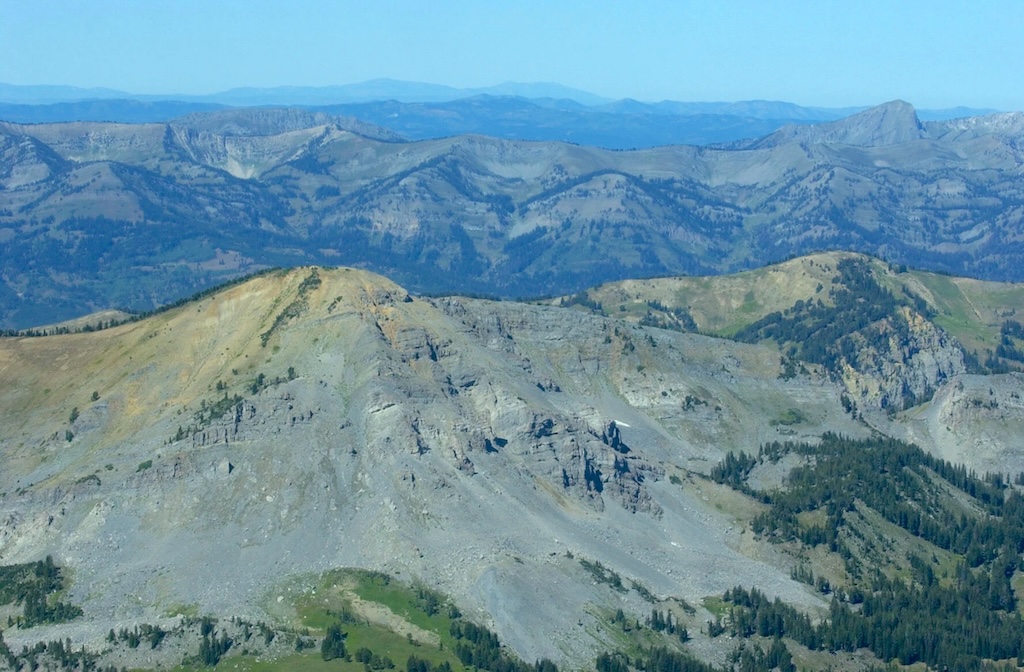Trump administration to end ‘Roadless Rule,’ opening up Greater Yellowstone to logging
By Wyoming News Exchange
June 25, 2025

The Trump administration has moved to end the 2001 “Roadless Rule,” which prevents most logging and road development in remote parts of national forests. That includes the Wyoming Range on the Bridger-Teton National Forest. Photo by Bradly J. Boner, Jackson Hole News&Guide.
• Lincoln County legislator sees repealing Clinton-era ‘Roadless Rule’ as way to stimulate economy.
By Billy Arnold
Jackson Hole News&Guide
Via- Wyoming News Exchange
JACKSON — The Trump administration has ended a decades-old rule protecting roadless areas in national forests, which could open millions of acres in the Greater Yellowstone Ecosystem to timber harvest.
The decision is not, however, final and will need to go through a public comment and rulemaking period.
Whether the logging industry will return to the areas around Jackson Hole remains to be seen.
Logging mostly has been dormant in western Wyoming since the 1980s, when the last sawmills in Dubois and Afton shuttered.
But Dan Dockstader, a Republican who represents Lincoln County in the Wyoming Senate, hopes that the end of the Clinton-era “Roadless Rule” will help the industry revive.
“We’ve got to try to bring it back. Once you shut it down, business goes away and all of the associated business goes away,” Dockstader said. “This opens up an opportunity where we can step back and say, ‘Is it time to rebuild some of these businesses that went away because of these restrictions?’”
Susan Marsh, a Jackson writer and conservationist who worked for the Bridger-Teton for more than 30 years, said the regulation was an effort to preserve wilderness areas, as some states were still considering wilderness bills at the time.
“I’m surprised it survived as long as it did,” Marsh said.
The Roadless Rule was passed by President Bill Clinton’s U.S. Forest Service in early 2001, decades after the last sawmills in western Wyoming closed. At the time of the rule’s adoption, the Forest Service already was managing more than 380,000 miles of roads. The ban on building new roads protected nearly 60 million acres of public land, aiming to protect undisturbed soil, water and air, public drinking water and endangered species such as grizzly bears.
At the time a Forest Service planner said the rule would have “minimal impact” on the way business was conducted on the Bridger-Teton National Forest, which covers 3.4 million acres. Its neighbors in Wyoming and eastern Idaho, the Shoshone and Caribou-Targhee national forests, cover another 5 million acres. In 2000, about 2.8 million acres across those national forests were inventoried as “roadless.”
Most road building and timber harvest is now prohibited in those areas, with exceptions for public health, safety and disaster response, and small-diameter timber harvest, among other things.
Clinton’s decision to adopt the Roadless Rule in the last two weeks of his presidency — intended largely to protect the Tongass National Forest in Alaska — spurred scorn from critics and, in the past 24 years the rule has been litigated multiple times, including by Western states such as Wyoming. Critics say the regulation was a federal overreach that attempted to improperly designate wilderness areas while limiting timber harvest and increasing wildfire risk.
U.S. Rep. Harriet Hageman, R-Wyoming, has been one of the rule’s fiercest critics and led legal challenges to its implementation in the early 2000s, leading conservationists to call her the “Wicked Witch of the West.”
On Monday, President Donald Trump’s Secretary of Agriculture Brooke Rollins announced the rule’s end.
“This misguided rule prohibits the Forest Service from thinning and cutting trees to prevent wildfires, and when fires start the rule limits our firefighters’ access to quickly put them out,” Rollins told reporters at the Western Governors Association meeting in Santa Fe. “After the repeal of this rule, we are going to go back to commonsense forest management to ensure our forests are here for generations to come.”
The Roadless Rule was passed after a wave of lawsuits over timber sales in the 1990s, largely filed by conservationists looking to protect old growth forests in the Pacific Northwest. It also came after the U.S. Forest Service reviewed roadless areas larger than 5,000 acres in the 1970s to determine whether they should be designated as “wilderness,” a formal designation that prevents motorized use of any kind.
With the rule on the outs, Marsh, the conservationist and longtime forest staffer, says some of the inventoried roadless areas where logging — and road development — were prohibited now could open both to timber harvest and oil and gas development.
“But because of their topography and the fact that all the easy roads have already been built, I don’t see a huge change immediately,” Marsh said.
She also cautioned that the rule’s likely end isn’t the end of environmental protections, writ large. The Forest Service still has to plan the land it manages and determine what uses can go where.
“I don’t think it’s wide open, but we’ll see,” Marsh said. “These days it’s hard to know if you can predict anything. We’ll be lucky if we have any public land at all by the time this is finished.”

